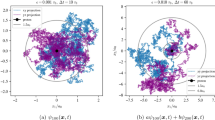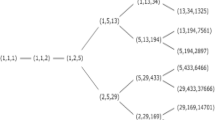Abstract
Since the proposition of the standard form of Morse potential \(\left({V}_{SM}\left(r\right)\right)\) model over the years, there has not been much attention on the potential. Its application to different studies such as the thermodynamic properties and information theory are yet to be reported to the best of our understanding. In this study, the solutions of the radial Schrödinger equation for the standard Morse potential is obtained using supersymmetric approach. The effect of the quantum number on the energy eigenvalue for the standard Morse potential is examined numerically for the hydrogen molecule (H2), lithium molecule (Li2), and potassium molecule (K2). Using the energy equation and the wave function obtained, the theoretic measures and thermodynamic properties of hydrogen, lithium, and potassium molecules are calculated via maple program. It has been shown that the energy of the standard Morse potential is fully bounded for the three molecules studied. A higher concentration of electron density corresponds to a strongly localized distribution in the position configuration. The Beckner, Bialynicki-Birula, and Mycieslki (BBM) inequality is satisfied for both the ground state and the first excited state. Finally, the product of uncertainty obtained obeyed the Heisenberg uncertainty relation.










Similar content being viewed by others
Data availability
The data used in the study are in the text.
References
Falaye BJ, Oyewumi KJ, Ikhdair SM, Hamzavi M (2014) Eigensolution techniques, their applications and Fisherʼs information entropy of the Tietz-Wei diatomic molecular model. Phys Scr 89:115204
Falaye BJ, Ikhdair SM, Hamzavi M (2015) Shifted Tietz-Wei oscillator for simulating the atomic interaction in diatomic molecules. J Theor Appl Phys 9:151–158
Khordad R, Ghanbari A (2021) Theoretical prediction of thermal properties of K2 diatomic molecule using generalized Mobius square potential. Int J Thermophys 42:115
Nasser I, Abdelmonem MS, Bohlouli H (2007) The rotating Morse potential model for diatomic molecules in the tridiagonal J-matrix representation: I. Bound states. J Phys B: Atomic Mol Opt Phys 40:4245
Dong Q, Torres-Arenas AJ, Sun G-H, Camacho-Nieto O, SmainFemmam S-H (2019) Exact solutions of the sine hyperbolic type potential. J Math Chem 57:1924–1931
Dong S, García-Ravelo J, Dong S-H (2007) Analytical approximations to the l-wave solutions of the Schrödinger equation with an exponential-type potential. Phys Scr 76:393–396
Yahya WA, Issa K (2015) Approximate analytical solutions of the improved Tietz and improved Rosen-Morse potential models. Chin J Phys 53:060401–060411
Liu H-B, Yi L-Z, Jia C-S (2018) Solutions of the Klein-Gordon equation with the improved Tietz potential energy model. J Math Chem 56:2982–2994
Oluwadare OJ, Oyewumi KJ (2018) Energy spectra and the expectation values of diatomic molecules confined by the shifted Deng-Fan potential. Eur Phys J Plus 133:422
Oyewumi KJ, Sen KD (2012) Exact solutions of the Schrödinger equation for the pseudoharmonic potential: an application to some diatomic molecules. J Math Chem 50:1039–1059
Zhang L-H, LI X-P, Jia C-S (2011) Approximate solutions of the Schrodinger Equation with the generalized Morse potential model including the centrifugal term. Int J Quant Chem 111:1870–1878
Zarezadeh M, Tavassoly MK (2013) Solution of the Schr¨odinger equation for a particular form of Morse potential using the Laplace transform. Chin Phys C 37(4):043106
Jia C-S, Cao S-Y (2013) Molecular spinless energies of the Morse potential energy model. Bull Korean Chem Soc 34:3425
Onate CA, Egharevba GO, Bankole DT (2021) Eigensolution to Morse potential for Scandium and Nitrogen monoiodides. J Nig Soc Phys Sci 3:282–286
Chatterjee S, Ali G, Talukdar SB (2020) Fisher information for the Morse oscillator. Rep Math Phys 85:281–291
Miraboutalebi S, Rajaei L (2014) Solutions of N-dimensional Schrὅdinger equation with Morse potential via Laplace transforms. J Math Chem 52:1119–1128
Sun G-H, Dong S-H (2012) Morse potential in the momentum representation. Commun Theor Phys 58:815–818
Dong S-H, Lemus R, Frank A (2002) Ladder operators for the Morse potential. Int J Quant Chem 86:433–439
Du J-F, Guo P, Jia C-S (2014) D-dimensional energies for scandium monoiodide. J Math Chem 52:2559–2569
Shui Z-W, Jia C-S (2017) Relativistic rotation-vibrational energies for the 107Ag 109Ag isotope. Eur Phys J Plus 132:292
Taseli H (1998) Exact solutions for vibrational levels of the Morse potential. J Phys A: Math Gen 31:779–788
Qiang W-C, Dong S-H (2007) Analytical approximations to the solutions of the Manning-Rosen potential with centrifugal term. Phys Lett A 368:13–17
Dong S-H, Qiang W-C, Sun GH, Bezerra VB (2007) Analytical approximations to the l-wave solutions of the Schrodinger equation with the Eckart potential. J Phys A: Math Theor 40:10535–10540
Greene RL, Aldrich C (1976) Variational wave functions for a screened Coulomb potential. Phys Rev A 14:2363
Wei G-F, Dong S-H (2010) Pseudospin symmetry in the relativistic Manning-Rosen potential including a Pekeris-type approximation to the pseud-centrifugal term. Phys Lett B 686:288–292
Wei G-F, Dong S-H (2010) A novel algebraic approach to spin symmetry for Dirac equation with scalar and vector second Pὅschl-Teller potentials. Eur Phys J A 43:185–190
Cooper F, Khare A, Sukhatme U (1995) Upersymmetry and quantum mechanics. Phys Rep 251:267
Witten E (1981) Dynamical breaking of supersymmetry. Nucl Phys B 185:513
Cooper F, Freeman B (1983) Aspects of supersymmetric quantum mechanics. Ann Phys 146:262
Suna G-H, Aokia MA, Dong SH (2013) Quantum information entropies of the eigenstates for the Poschl–Teller-like potential. Chin Phys B 22:050302
Sun G-H, Dong S-H (2013) Quantum information entropies of the eigenstates for a symmetrically trigonometric Rosen–Morse potential. Quantum information entropies of the eigenstates for a symmetrically trigonometric Rosen–Morse potential. Phys Scr 87:045003
Valencia-Torres R, Sun G-H, Dong S-H (2015) Quantum information entropy for a hyperbolical potential function. Phys Scr 90:035205
Sun G-H, Dusan P, Oscar C-N, Dong S-H (2015) Shannon information entropies for position-dependent mass Schrodinger problem with a hyperbolic well. Chin Phys B 24:100303
Song X-D, Sun G-H, Dong S-H (2015) Shannon information entropy for an infinite circular well. Phys Lett A 379:1402–1408
Olendski O (2021) Comparative analysis of information measures of the Dirichlet and Neumann two-dimensional quantum dots. Int J Quant Chem 121:e26455
Olendski O (2019) Rényi and Tsallis entropies: three analytic examples. Eur J Phys 40:025402
Peng X-L, Jiang R, Jia C-S, Zhang L-H, Zhao Y-L (2018) Gibbs free energy of gaseous phosphorus dimer. Chem Engen Scien 190:122–125
Jia C-S, Zhang L-H, Peng X-L, Luo J-X, Zhao Y-L, Liu J-Y, Guo J-J, Tang L-D (2019) Prediction of entropy and Gibbs free energy for nitrogen. Chem Eng Sci 202:70–74
Wang J, Jia C-S, Li C-J, Peng X-L, Zhang L-H, Liu J-Y (2019) Thermodynamic properties for carbon dioxide. ACS Omega 4:19193
Jia C-S, Li J, Liu Y-S, Peng X-L, Jia X, Zhang L-H, Jiang R, Li X-P, Liua J-Y, Zhao Y-L (2020) Predictions of thermodynamic properties for hydrogen sulfide. J Mol Liquids 315:113751
Liang D-C, Zeng R, Wang C-W, Ding Q-C, Wei L-S, Peng X-L, Liu J-Y, Yu J, Jia C-S (2022) Prediction of thermodynamic properties for sulfur dioxide. J Mol Liquids 352:118722
Abu-Shady M, Khokha EM (2022) On prediction of the fractional vibrational energies for diatomic molecules with the improved Tietz potential. Mol Phys 120:e2140720. https://doi.org/10.1080/00268976.2022.2140720
Wang C-W, Peng X-L, Liu J-Y, Jiang R, Li X-P, Liu Y-S, Liu S-Y, Wei L-S, Zhang L-H, Jia C-S (2022) A novel formulation representation of the equilibrium constant for water gas shift reaction. Int J Hydrogen Energy 47:27821–27838
Wang C-W, Wang J, Liu Y-S, Li J, Peng X-L, Jia C-S, Zhang L-H, Yi L-Z, Liu J-Y, Li C-J, Jia X (2021) Prediction of the ideal-gas thermodynamic properties for water. J Mol Liquids 321:114912
Author information
Authors and Affiliations
Contributions
Formulation of the work: C.A. Onate. Calculations: C.A. Onate and E. Omugbe. Introduction: I.B. Okon and U.E. Vincent. Editing: M.C. Onyeaju. Numerical results/plotting: I.B. Okon and E.S. Eyube. Discussion of results: G.O. Jude.
Corresponding author
Ethics declarations
Ethical approval
Not applicable.
Competing interests
The authors declare no competing interests.
Additional information
Publisher's note
Springer Nature remains neutral with regard to jurisdictional claims in published maps and institutional affiliations.
Rights and permissions
Springer Nature or its licensor (e.g. a society or other partner) holds exclusive rights to this article under a publishing agreement with the author(s) or other rightsholder(s); author self-archiving of the accepted manuscript version of this article is solely governed by the terms of such publishing agreement and applicable law.
About this article
Cite this article
Onate, C.A., Okon, I.B., Vincent, U.E. et al. Theoretic measure and thermal properties of a standard Morse potential model. J Mol Model 29, 34 (2023). https://doi.org/10.1007/s00894-022-05441-z
Received:
Accepted:
Published:
DOI: https://doi.org/10.1007/s00894-022-05441-z




